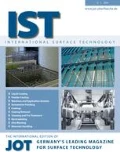Two oscillating chamber shot blasting systems incorporated into the existing production lines of a car manufacturer in southern Germany allow cylinder heads to be partially shot blasted.
After the cylinder heads have undergone the first machining process, they have milling burrs and in some cases are contaminated with sand from the casting process. In order to remove these, the car manufacturer integrated two identical blasting machines into its existing production lines.
This gave rise to one of the first challenges faced by the blasting machine manufacturer, because the machines had to fit in a predefined space. Another requirement concerns the area to be blasted. Only the combustion chamber side of the cylinder heads needs cleaning and three drilled holes have to be left untouched. In addition, an existing data matrix code must not be damaged.
The manufacturer opted for the compact RWK 6/12-2 oscillating chamber shot blasting machine from Rösler with a component processing circle of 600 mm and a height of 1200 mm. Each machine has two chambers, so that loading and unloading can take place in parallel with the blasting process. The machines are also equipped with two Hurricane H 32 blast turbines with a power output of 7.5 kW.

The special gripper system developed for the loading and unloading robot can pick up the cylinder heads in two different positions.

The compact oscillating chamber blasting machines were integrated into the existing production lines.
Positioning, covering and blasting the cylinder heads in 60 seconds
The parts are transported to the blasting machines on roller conveyors. They are removed from the conveyor by a robot with a special gripper system developed by Rösler which makes it possible to pick up the cylinder heads at different points. Firstly, the system takes hold of the cylinder head by one bracket and transports it to a handover station. The second move involves placing the component on the holder specially designed for the purpose. The area to be blasted is on top and the three drilled holes and the matrix code are automatically blocked with pins or covered with a plate.
Once the cylinder head has been fastened to the holder, the machine moves it into the blasting chamber. This is made from manganese steel and is fitted with additional exchangeable wall panels. The part holder oscillates during the blasting process. The movement ensures that only the necessary areas of the cylinder head are blasted. After the blasting process, the cylinder heads return to the loading and unloading area where the robot moves them in a special way to remove any remaining blasting agent and replaces them on the roller conveyor. The entire process, including loading, unloading, covering and blasting, takes 60 seconds. In order to prevent any sand removed from the cylinder heads from entering the blasting material circuit, the machines are fitted with special separation systems which separate the sand and swarf from the shot.
Author information
Authors and Affiliations
Rights and permissions
About this article
Cite this article
Schulz, D. Partial Shot Blasting of Cylinder Heads. Int Surf Technol 6, 42 (2013). https://doi.org/10.1365/s35724-013-0180-9
Published:
Issue Date:
DOI: https://doi.org/10.1365/s35724-013-0180-9

